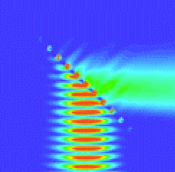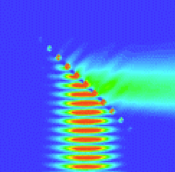Sharp turn ahead for light beams
Over the last decade, the field of optics has been turned on its head by artificial materials that bend light in ways that no natural material can. In a new development, theorists have shown that a carefully designed array of tiny rods can deflect a light beam at a sharp angle. As explained in Physical Review Letters, this unique light response is due to interference in the resonant emission from the rods. Arrays like this might help steer light inside fiber optic networks or an optical computer.
Optical wonders like cloaking devices and superlenses rely on negative refractive index materials to radically alter the path of light. These metamaterials typically contain arrays of small metallic components, but researchers are also starting to look at dielectric components. In this vein, Junjie Du of the Chinese Academy of Sciences in Shanghai and his colleagues theoretically investigated how light scatters off half-micron-wide silicon rods when they are lined up like the bars on a cage.
Because of silicon’s strong dielectric properties, each rod resonates like an electric dipole when excited by infrared light. If the rod spacing is chosen just right, the emissions from the different dipoles interfere with one another, resulting in a single beam coming out on the same side of the normal as the incoming beam. The researchers call this negative transmission because, unlike negative refraction, the outgoing beam is in the same medium as the incoming one. The rods may find uses in photonic circuits where their compact size and nearly lossless transmission would be a plus. – Michael Schirber





